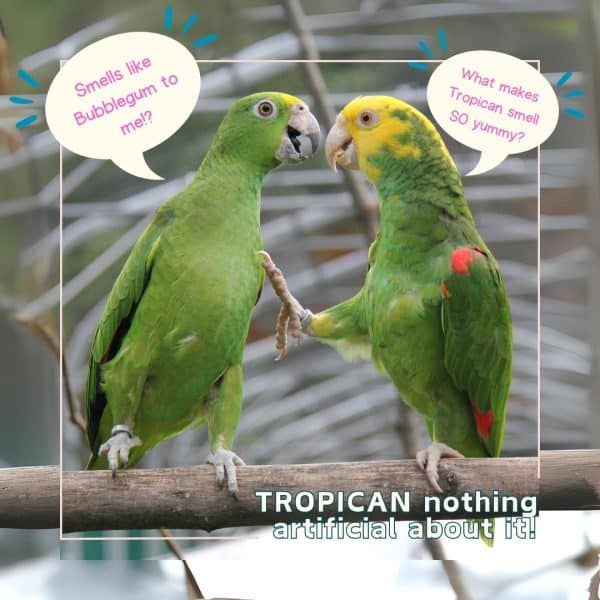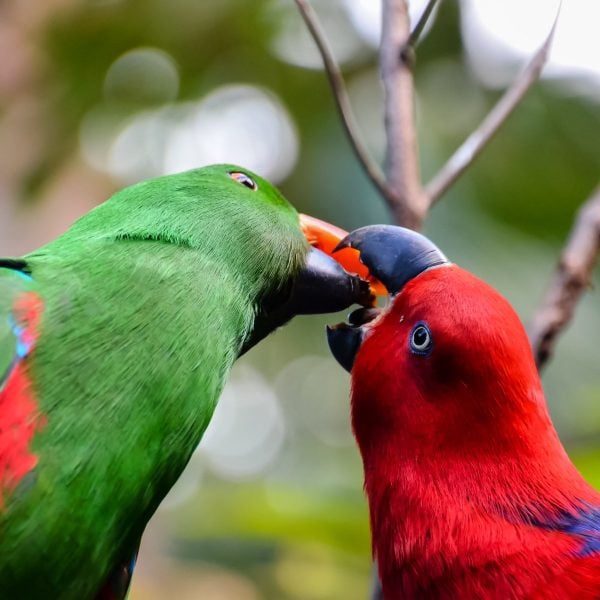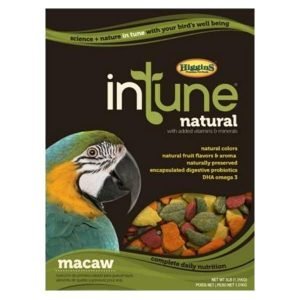Last Updated on by Catherine Tobsing
I am getting this so I can stay warm. Editor’s note: we don’t know what bird food your bird will like any more than if you are a fan of “Transparent”, “Scandal” or “The Walking Dead” on Netflix.
We do know that instinctively your bird has a desire to “search” or “forage” for food seven days a week. Have you asked yourself why you have filled up six food dishes in your bird’s cage because your bird will be locked up for 12 hours during YOUR workday?
Have you considered that your bird would really rather have his or her OWN workday rather than six dishes overflowing with food?
When asked “What’s the best pellet for my bird”, I tell them “The one your bird will eat”. – Catherine Tobsing.
In the wild natural feeding times are about a 1/2 hour after sunrise and again at about a 1/2 hour before sunset. Perhaps you should try to introduce (new) foods within this time frame.
Big birds may enjoy fruits and vegetables throughout the day to munch on and play with. Sticking close to these feeding times will be most natural for your companion birds. Larger breeds can have fruits or vegetables left in the cage through the day for snacking and entertainment.
Smaller breeds will typically have seeds left in the cage throughout the day. They (smaller birds) need to eat more frequently throughout the day due to their higher metabolic rate and energy needs.
If you introduce veggies to your small or large bird, frozen mixed vegetables are cheap and easy at around a dollar or so a package. It’s not required to allow them to thaw before placing in the cage early in the day. In winter we like to run some cold water over them for about 10 seconds just to get the chill off. They will stay fresher longer.
Windy City Parrot is determined to satisfy the nutritional needs of approximately 350 species of parrots and 372 species of parakeets. If you combine all the Hookbills, Hardbills, Softbills and Waxbills we figure we can provide nutritional advice and support for about 1000 species.
Furry factoid: There is only one species of dog (Google it)
How hard can it be to feed a dog? If it’s a smart dog it will feed itself.
Editor’s note: I have a friend who just got a dog that’s a half pit bull and half Collie. First, it bites you, and then it runs for help (my only dog joke).
The captive birds that we keep locked up in their cages have no nutritional choice. It’s totally up to the humans. Thus to the non-caged Birdkeeper, bird food is something that is sold in big bags at Menards cheaply and will satisfy the need of any bird. We like to make the distinction that our pet birds are so much more sophisticated than those “wild backyard” birds.
But even wild birds have different nutritional needs. Woodpeckers eat differently than hummingbirds who eat differently than orioles. In reality, all birds in the wild (including the one pooping on the cage behind you), are scavengers. In their natural habitat birds will eat almost anything BUT are guided by what mother nature has ingrained in them, to seek out.
Scientifically “exotic” birds can be classified by their diets.
Granivore – Primary diet of grains and seeds
Parrots we consider Grainovores are Budgerigar, Cockatiel, Hyacinth macaw
Frugivore – Primary diet of mostly fruits and flowers with some additional nuts and seeds – Parrots we consider Frugivores are Blue-throated macaw, Green-winged macaw
Florivore – Primary diet of seeds, fruits, nuts, bark, roots, and berries – parrots we consider Florovores are Military macaw, and Blue and gold macaw
Omnivore – Primary diet of seeds, fruits, insects, and invertebrates – parrots we consider Omnivores are Blue-throated macaw, Green-winged macaw
Nectarivore – Primary diet of nectar, pollen, and some insects and seeds – Parrots we consider Nectivores are Lorikeets
Now we know that if we see a picture of a macaw on a bag of bird food, that food is not necessarily always suitable for “your” macaw. To muddy the waters further a scarlet macaw is classified as a frugivorous-granivorous “crossing over” with their diet.
It’s obvious here that we have multiple species of macaws in different dietary categories. As an example, Hyacinth macaws prefer palm nuts as their primary source of nutrition while budgies are seed eaters. But our birds aren’t in the wild they’re in our homes and they’re not very active and so they have a lesser need for so many calories.
The “experts” tell us that our pet bird’s diet should be 50% commercial food and 50% fresh food. How much of this bowl of fresh food is Popcorn going to actually consume? Personally, I think 50% fresh food is a pretty optimistic number which brings us back to commercial diets.
Like she even cares let alone gets as far as the one piece of brown lettuce.
Most birds like seed-based diets for the same reason you and I like French fries and potato chips – the fat which makes the nummy flavor while adding inches to our hips. So how is the information I’ve laid out so far going to help you select your next bag of bird food?
If you spend any time on our WindyCityParrot you’ll see that we have buttons in the majority of our listings explaining what “size bird” that particular product is suitable for. This helps somewhat with the “size?” of the seed/nut/pellet relative to the size of the bird.
Last week we briefly talked about peanuts and birds. Birds should have unsalted peanuts. The normal human response to unsalted nuts of any kind is “eww”. I like salted peanuts in the shell”. The question I need to be answered is – how do they get the peanuts to taste salty while the “nut” never leaves the “shell”?
Short answer: the shelled peanuts are soaked in a brine solution and then the air is sucked out of the peanuts so the salty brine gets pulled inside the peanut shells.
These actually look pretty good
The bird food manufacturers all make similar claims about their bird seed being “vitamin fortified.” Unlike the folks who make salted peanuts, the companies making bird seed blends are adding their vitamin and supplement fortifications to the outside of the husks and shells.
For those of you that have not purchased one of our mess-less acrylic feeders I would like you to take a moment and look at the debris under your bird’s cage. During molting season there will be feathers in addition to what you’re looking at now. I can guarantee you that will there always be plenty of husks and shells that have been discarded by your bird in the process of consuming nuts and seeds.
Those husks and shells, on the floor under your cage are where all the “added” vitamins supplements and minerals went.
I rest my case
Fathered factoid: as much as 30% of a bird’s calories are used in the production and maintenance of feathers.
What got me started on this whole picking the right bird food for my bird thing was the reorganization of how we present our ALL products to you. We have re-thought our website by paying special attention to helping you find answers quicker.
To make it easier to find things, once you land on the “nutrition” category, all products are one click away in any category. Less clicking, less “drilling down”, finding the next sub of this and sub of that.
When you search other websites selling bird food you’ll see articles on things like the Nutrient Requirements of pet birds.
What Proteins & Amino Acids do your birds need to survive? Which vitamins are necessary to keep your bird’s metabolism functioning perfectly?
Minerals – we talk a lot about calcium in brooding birds but what other minerals do our birds require? Should I feed my bird a “formulated” aka “pellet” diet, a seed diet, or a blended diet? At the end of the day, they always cover their ass by saying “but be sure to consult with your avian veterinarian.”
I love this picture – it redefines what dumbasses we all are. Much like as little as 20 years ago, the “experts” thought that red Eclectus and green Eclectus parrots were two separate species – a year or two ago, a backyard birder in Australia discovered that sweet little lorikeets slurped more than nectar and ate more than seeds, They’re CARNIVORES (meat eaters) – our birds have so much to teach us.
A lot of these articles summarize with something like “make sure you talk to your avian veterinarian about proper nutrition”. Their definition of proper nutrition is what they are stocking in inventory, meaning they will try to sell you what they have “on hand”. The sell what you got in stock retailer mentality.
This is why regardless of your plans on Saturday, you end up at our “Birdie Brunch” on Sunday. Helping us to set the record straight.
I don’t care if you buy a thing but I’d really like you to visit our new nutrition category to tell us if we are doing the right thing? Could we organize it any better? Could we make it more educational? Please post your comments below.
We hear the words “my bird won’t….” Fill in the blank – a lot. Perhaps the time it is convenient for you to feed your bird is not the time nature intended for your bird to eat.
Let’s talk about Higgins. They make an engineered pellet called InTune. If you are concerned that your bird won’t accept pellets, every other bird food in the Higgins line has InTune pellets as part of the formula. Your bird is getting engineered nutrition in every seed and fruit blend Higgins offers without knowing it and without having the opportunity to reject a dish of pellet bird food – out of hand. InTune pellets bind their entire bird food line together making it ideal for any exotic bird.
It’s no accident that Higgins is popular with caged bird keepers. What sets them apart is the depth of the product line. It’s not that they offer simply a lot of products, they “brand” each of their seven lines into seven unique caged Bird keeper solutions.
Higgins Nederlands Vita Seed® brand is now Higgins Vita Seed® natural with added vitamins, minerals, and trace nutrients. Vita Seed® is now free of artificial colors! Vita Seed is also free of artificial preservatives and flavors and enriched with DHA and balanced Omega-3 fatty acids to support the immune system as well as encapsulated pro-biotics for a healthier digestive tract.
Vita Seed® blends premium seeds with dried fruits, vegetables, and nuts for added variety and nutrition to your pet’s diet. Vita Seed® also contains Higgins inTune® Natural extruded morsels for added nutrition. Vita Seed® is available in shelf-sized, stand-up, resealable packaging as well as resealable, barrier bulk bags.
Sunburst
Sunburst® Gourmet Blends feed from finch to macaw.
Higgins uses natural and healthy, high-end sources for nutritional fat like coconut fat and macadamia nut meal. Many competing brands use economical and simple vegetable or soy oil as their source of fat.
InTune does not use chemical preservatives like Ethoxyquin and BHA/BHT used by competing brands.
Is free of fillers like wheat middlings, a wheat mill by-product with no nutritional value. The two leading competing brands list wheat middlings as their sixth ingredient on their respective ingredient labels. inTune’s sixth ingredient on their labels: bananas.
The bird food also uses encapsulated pro-biotics to help insure a higher level of live, digestive cultures. Competing brands use freeze-dried pro-biotics that do not have a long shelf life.
Mayan Harvest is Higgins’ newest and most innovative seed brand yet. Inspired by the lost civilization that cherished and worshiped the native birds of South America, Mayan Harvest brings together exotic, natural ingredients and holistic herbs.
The results are premium seed, nut and fruits blended to be as unique as their name. Mayan Harvest is free of artificial colors and preservatives. All the diets in the Mayan Harvest brand contain natural bee pollen.
Gourmet Blends by Higgins. NO Artificial Colors, No Artificial Preservatives.
Safflower Gold is now Natural with added vitamins, minerals and amino acids. Safflower Gold has no sunflower seeds and uses premium gourmet ingredients that are free of artificial colors and preservatives. DHA and balanced Omega-3 fatty acids are added to support the immune system as well as encapsulated probiotics, ensuring a higher level of active in beneficial microorganisms for a healthier digestive system.
Safflower Gold also has Higgins InTune Natural extruded morsels for added nutrition. Available in 3-pound and 25-pound poly laminated, resealable bags in Cockatiel & Conure size and Parrot size.
Higgins, the avian and small animal specialists who formulate the freshest premium diets available, now bring you the best treat for your pet. Higgins Gourmet Treat Sticks are the treat feasts your pets have been waiting for.
Higgins Worldly Cuisines are natural, healthy foods that add variety to a companion bird’s daily diet. Worldly Cuisines will transport your customer’s bird food to different parts of the world with human edible ingredients.
These exotic cuisines contain wholesome ingredients like sea kelp, organic couscous, basmati rice, papaya, apples, cranberries, lentils, dates, tomatoes, anise, ginger, and more!
Editors note: if you’re curious to know the names of the species on the Higgins category icons, you’ll have to visit our nutrition category where we have a clickable link to map all 44 species on that page.
Now available in microwaveable bags
There are even cuisines that include organic quinoa, known for being one of the best sources of vegetable protein. Worldly Cuisines cook up fast on your stovetop and fill the air with an intoxicating aroma of different spices.
Parrot owners will not only enjoy the easy preparation of Worldly Cuisines but will participate in the satisfaction their bird receives in foraging and eating this unique food. In re-sealable, nitrogen flushed barrier bags.
Written & Approved by
Catherine Tobsing & Mitch Rezman
Author Profile
Latest entries
 PigeonsJune 20, 2025How Do Parrots Thrive in Cities Outside Their Native Habitats?
PigeonsJune 20, 2025How Do Parrots Thrive in Cities Outside Their Native Habitats?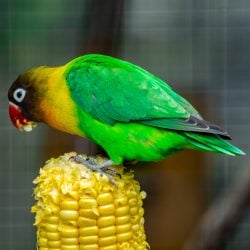 Feeding Exotic BirdsJune 20, 2025Is Corn On the Cob Safe for Pet Birds?
Feeding Exotic BirdsJune 20, 2025Is Corn On the Cob Safe for Pet Birds? Bird & Parrot AnatomyJune 19, 2025Would You Like a Comprehensive Guide for Training Your Bird?
Bird & Parrot AnatomyJune 19, 2025Would You Like a Comprehensive Guide for Training Your Bird?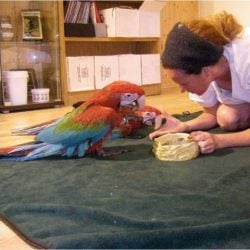 Feeding Exotic BirdsJune 19, 2025Here Are Three (Video) Strategies to Help Your Bird Forage
Feeding Exotic BirdsJune 19, 2025Here Are Three (Video) Strategies to Help Your Bird Forage

